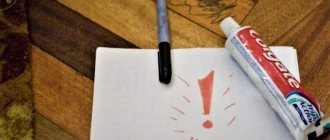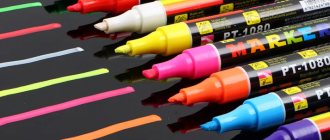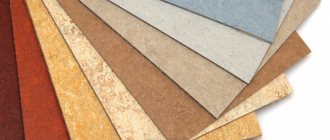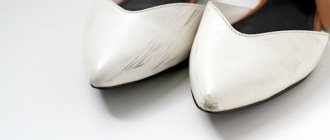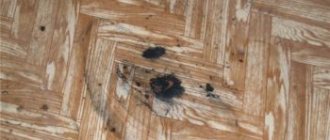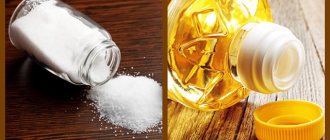If there are small children in your home, then you should be familiar first-hand with the consequences of their pranks when these fidgets explore the world. Children love to draw, and they absolutely do not care where they do it, they are ready to take advantage of any opportunity presented to them. It is clear that they especially like those surfaces on which it is easiest to leave drawings. For example, these could be walls, parquet, linoleum. However, adults are not always pleased to see the creativity of young artists on their household items, but, as you know, no matter what a child enjoys...
Children can draw and do their creativity with any object that comes to hand. For example, a marker, felt-tip pen or ballpoint pen.
How to remove marker from linoleum
Before you scrub the marker off the linoleum, there are two important details you need to know. Firstly, the composition of the marker, and, secondly, the time that has passed since the contamination. Depending on the composition, you can wipe off the marker from linoleum using various means. Of course, the easiest way to cope with this task is when the linoleum has been damaged very recently. The longer you leave the dirt, the deeper it eats into the surface.
- Sometimes a simple soap solution is enough to wipe the marker off the linoleum. You need to take soapy water, moisten a rag or sponge in it, and rub the stained area with this rag or sponge. Unfortunately, this method will only work for very recent drawings. Remember, it may take some time and effort to remove marker from linoleum; do not expect to be able to do it instantly.
- If your marker is based on water, then often a solution of warm water and washing powder is enough to remove such a marker from linoleum. Soak a sponge in this solution and wipe the stained area.
- In the case of an alcohol-based marker, warm water will not be enough. In this position, to wipe the marker off the linoleum, you will need alcohol-containing products or pure alcohol. You can use nail polish thinner, cologne or vodka.
In order to give markers a particular color, various substances are used in their production, which are sometimes quite difficult to remove from the surface. The most difficult colors to breed are red, black and blue. A marker of this color can be washed off linoleum using white spirit.
But be very careful when using this product. Since it can corrode linoleum, it is better to rinse the surface thoroughly with water after cleaning .
Sometimes you can remove markers from linoleum using toothpaste. To get rid of stains using it, you should apply it to the stain and rub it over the surface with a napkin, then rinse the area with water and wipe the surface dry.
How to choose the right stain remover
The photo shows stain removers.
Not initially knowing how to wipe off the resulting dirt from linoleum, many of us begin to use all the means at hand. But the choice of method and reagent depends on the type and composition of the dirt or stain, but the main danger is that linoleum can be very sensitive to most of these chemical compounds.
Attention! All work on removing stains with various cleaning agents and compounds should be carried out carefully and as quickly as possible. And after that, be sure to remove their residues from the surface using a dry or wet method. In this case, you need to follow the hint that the instructions for using the product you used will tell you about.
How to erase permanent marker from the floor (linoleum)
A permanent marker differs from a felt-tip pen and a regular marker in that it uses particularly durable ink that adheres well even to slippery and wet surfaces. Because of this, it is quite difficult to remove permanent marker from linoleum, but it is possible.
In this case, soap solution, alcohol-based products, including hairspray, acetone and white spirit will also help. The only difference is that it will take much more time and effort to remove a permanent marker from linoleum, but otherwise the process is identical to removing a regular marker.
How to get rid of paint marks on linoleum after renovation
The photo shows paint stains on the linoleum.
The beauty and cleanliness of linoleum may be threatened by routine cosmetic repairs. Even with the floor covering securely covered with plastic film, there may be droplets of paint on its surface.
In this case, it is also important to be prompt and have a sufficient amount of soft rags on hand during repairs, since in a hurry, most types of paint can be easily removed with a dry cloth, gently wiping the surface, while trying not to smear the stain.
You shouldn’t worry too much about how to wipe the paint off the linoleum if it’s a water-based emulsion - even if it’s slightly dried, it can be easily removed from the surface with a damp or well-wetted rag. It is more difficult with enamels or oil and other types of paints, although fresh enamel can also be dry cleaned, provided that it is only small droplets.
Mechanical method: how to do everything right
The photo shows mechanical paint removal.
In all other cases, you will have to choose, based on the area of contamination and the age of the stain itself, a method of removing paint from the surface with your own hands, mechanical or chemical. Naturally, each has its own disadvantages and effectiveness.
It is more preferable to remove paint mechanically, for example, with sandpaper. However, this may not always provide ideal cleaning, especially on linoleum with a relief pattern or cracks. Finally, it is necessary to restore or renew the protective layer.
If you need to remove oil paint, especially dried paint, you can pre-lubricate the stain with ordinary vegetable oil for a couple of hours to make the work easier. Large smudges or accidentally spilled paint that has had time to dry should be removed mechanically, but not with abrasives.
Using a construction knife, or a shoemaker's knife, the entire frozen mass is carefully pryed off and removed. In the end, you may need to use chemicals for final cleansing.
Removal by chemical means
The photo shows paint solvents.
When using a chemical method to remove paint, it should be borne in mind that effective products can damage the material or its top layer, so you must work with great care. It is recommended to first test the possible aggressive consequences in a small area.
The choice of product for linoleum is determined not by the price, but by the type of paint itself and, as a rule, these are paint solvents, acetone, even nail polish remover can be useful, in extreme cases turpentine. Some paints lend themselves to gasoline.
Particular care must be taken if linoleum is a PVC product; the use of most available chemicals can simply dissolve not only its top layer, but also completely perforate the coating throughout its entire thickness.
How to Remove Shoe Paint from Flooring
Sometimes you have to think about how to remove shoe paint from linoleum, which is made on a nitro base. If the area is small, you should use acetone, or better yet, nail liquid, which is less aggressive, or solvents 646 or 647. Dried stains can even be simply scraped off.
If the stain is stubborn, you can try kitchen cleaners with the effect of soda, although it must be borne in mind that soda is one of the main enemies of linoleum, and such products should be used only in the most exceptional cases. Finally, thoroughly rub the treated surface to restore protection and appearance.
How to remove felt-tip pen from linoleum
Felt pens, like markers, can be water-based or alcohol-based. In this regard, in order to remove a felt-tip pen from linoleum, you need to do this as quickly as possible, before the marks dry out and become ingrained into the surface. In cases where it was not possible to take emergency measures, all that remains is to persistently remove the dirt using various detergents, alcohol-containing products, and acetone. Sometimes wiping with hydrogen peroxide applied to a tampon helps.
You can also remove a felt-tip pen from linoleum using specialized tools designed specifically for these purposes. You should look for such products in hardware stores in your city.
Iodine and brilliant green are not only for knees
Photo of greenery.
Recently, medications such as iodine and brilliant green are used less and less, but they are still found in almost every home, and accordingly there is a threat of spilling them on the floor. Therefore, the problem of how to remove iodine from linoleum can be very pressing.
In this case, the green stain is more unpleasant - it is more difficult and takes longer to remove, but with a fresh stain, hydrogen peroxide and some effort will achieve results. Turpentine can help with old or dried stains.
If the trace of green paint is barely noticeable and the area is open, then after a while it will disappear with regular washing and cleaning of the floor. Therefore, if such a stain does not greatly spoil the appearance, and there is no desire to ruin the coating, then it is better to wait a while. Sometimes it is justified to use a product containing chlorine or camphor alcohol.
Products containing active chlorine also help get rid of iodine on linoleum, although, given its volatility, you can simply wash the floor, and the stain will disappear on its own within a month.
Getting rid of paint
It won't be too difficult to remove fresh paint. Blot liquid drops of enamel with a rag, wipe the stained area with a wet rag and finish with a dry cloth.
- Fresh oil-based paint, even if it is promptly cleaned with a cloth, leaves cloudy stains on the floor.
- Pour sunflower oil over them and wait a couple of minutes. Collect the remaining oil with a napkin, and wash the grease stain from it in the household. soap.
- If traces of paint are still visible, you will have to use White Spirit. It will quickly remove paint stains.
- Use it carefully and wash the surface thoroughly immediately after use. Linoleum does not like the influence of solvents, gasoline, kerosene and other aggressive substances.
The hardened paint must first be carefully scraped off and then removed with the same solvent.
Removing traces of felt-tip pens and markers
Markers or felt-tip pen marks on the surface of the floor covering mainly appear in homes where children grow up.
Because of this, parents need to know very simple ways and means of how to wipe off a marker from linoleum, since they will have to do everything in reality many times.
- Rule one: wipe like things with like things. If the marker or felt-tip pen is water-based, warm water is used, you can dilute soap or powder, as when simply washing floors, and if it is alcohol-based, you will need to use the necessary substances, for example, vodka, although sometimes liquid used to remove nail polish nails, it will help.
- The second rule is to clean the surface quickly, especially marks from alcohol-based markers, before they are absorbed into the front layer, coloring it firmly and for a long time.
- Tetier's rule: you need to take into account that for the production of various flowers, good ones from one substance are used, some of them are especially difficult to remove. Particularly dangerous in this case are colors containing red, brown, and sometimes blue pigments.
What harms linoleum
In the photo - the owner’s “ambulance”
When choosing this type of flooring, you need to know the basic rules for caring for it, as well as how to effectively remove the most common stains and contaminants.
Attention! To preserve the appearance of the coating, the main rule is efficiency. It is necessary to try to remove contamination from the surface as soon as possible, since many substances can eat into the top layer.
This is especially dangerous for natural types of linoleum without a protective layer; subsequently it may not be possible to completely remove it. Also, in order to preserve the top layer, it is recommended to periodically rub the surface with mastics intended for linoleum, linseed oil, drying oil, and various polishes to form a protective barrier.
This is important for non-commercial products that do not have a protective layer, and in houses and apartments this type of material is mainly used. In addition, these measures allow the material to have a more attractive appearance, and also simplify and facilitate its care.
The types and types of contamination may also have a specific localization: for the kitchen area the most common type is grease stains, and in the hallway there may appear traces from shoes on which bitumen, including asphalt, dirt particles were brought from the street, or if as a result of cleaning shoe cream accidentally touched the surface of the linoleum.
Removing traces from furniture
Furniture, strictly speaking, leaves not stains on the linoleum, but dents and dented areas. In such cases, there is nothing left but replacing the damaged strip. If, by mistake, rubber or other staining pads are used for the legs, you need to act as you usually deal with stains of the corresponding type.
Furniture, both large and small (chairs, stools, bedside tables) leaves dents on the linoleum.
To clean dents you should:
- take a metal ball of small diameter;
- roll it along the edges of the dents in the coating several times to remove the deformation.
If the marks have not completely disappeared, then you should take a regular hairdryer and select warm or hot air. Then heat the edges of the dent (5-10 seconds), and then run the ball over the unevenness again.
Precautionary measures
If used incorrectly, home remedies to remove markers are not safe. When working with them you will need to take the following precautions:
- Hairspray, acetone and alcohol are flammable substances. They should not be used near open flame sources.
- Bleach leaves chemical burns on the skin and should not be used without rubber gloves. It is also forbidden to bring the jar close to your nose so as not to inhale toxic fumes.
- Before washing off the marker from your body, you must make sure that you are not allergic to the product. To do this, a drop of the substance is applied to the bend of the elbow or the back of the wrist. If there is no redness, itching, or rash, you are allowed to use the chosen method to clean all impurities on the body.
Cleaning carpet, upholstered furniture and clothing with the wrong product will damage them. Before using the method, it is better to test it on a separate piece of fabric, which is supplied as a sample for such experiments when purchasing an item. The main precaution is to try to keep markers out of the hands of preschool children. They are dangerous not only for the interior, but also for the child himself, if he decides to taste the felt-tip pen. If it was not possible to keep track, damaged items are cleaned immediately. Stubborn stains are more difficult to remove.
Plastic
Alcohol-containing products can help remove markers from plastic. To do this, take cognac, vodka or ordinary ethyl alcohol. But such a liquid should contain a minimum amount of dyes. Soak a cotton pad in alcohol and wipe away ink marks. Remaining liquid is removed with a napkin.
Acetone is a good remedy, but painted or varnished surfaces should not be treated with this substance, as the top layer of paint may come off.
Apply 5-6 drops of acetone to a rag and wipe the dirty area. To remove permanent marker from plastic, use a stain remover. It is applied to the mark of the felt-tip pen and left for 15-20 minutes.
We suggest you read: Clean aluminum blinds
Then apply a dry cloth and wash with water.
How to clean suede or leather shoes
The material of the shoe determines how to remove marker marks from it. Dermatin or leather is wiped with alcohol or acetone. These substances will not harm the skin or the substitute.
It is more difficult with suede shoes, especially if they are light-colored. To clean suede use:
- Milk. Suitable for light-colored shoes only. A napkin soaked in milk is applied to the soiled suede for 2-3 minutes. When it is soaked, rub it with a special brush for caring for nubuck. The stain is erased in 5-10 minutes.
- Semolina. A small amount of cereal is rolled over the stains until they disappear. The method is labor-intensive. Semolina must be changed after it changes color.
We suggest you read How to get rid of scratches on shoes
In case of extensive contamination, it is better to take the shoes damaged by marker to the dry cleaner. The workshop uses special reagents and solutions that will clean suede without harming the product.
Helpful cleaning tips
Before you start cleaning linoleum from old or fresh stains, it is advisable to familiarize yourself with the following recommendations:
- Any contamination should first be treated with an ordinary soap solution. There is a possibility that this may be enough to remove the stain, and other methods will not be needed at all.
- Aggressive chemicals (for example, gasoline, alcohol) are diluted with water before use, all components are used in the same quantity.
- The polymer coating does not tolerate extremely low and high temperatures. Therefore, you cannot wash linoleum with very hot water, or lay it in an unheated room.
- The solvent is applied only to rags, which are subsequently used to treat the contaminated area. It is unacceptable to apply aggressive liquid directly to the material.
- To clean the polymer base, it is not advisable to use hard sponges or brushes. To avoid accidentally damaging the surface, it is better to use softer materials.
- Upon completion of cleaning, the floor covering should be treated with a soapy solution, then wiped dry.
No one can say how one or another cleaning agent will affect a particular PVC material. In order for the cleaning process to be successful and new stains not to form on the treated surface, the purchased chemical must be tested in an inconspicuous area (somewhere under the sofa, crib).
Before you begin removing stains from the flooring, you need to prepare tools, cleaning compounds, and personal protective equipment. Source cleanadvice.ru
Polishing linoleum
Polishing should be done once or twice a month. Thanks to this, linoleum is covered with a protective film and also becomes shiny.
Before carrying out the procedure, you need to remove the old coating. This can be done using a special tool. Now we need to carry out wet cleaning of the PVC covering. After the floor has completely dried, a special polishing agent is dissolved in water and applied to the floor in several layers using a rag.
You can also restore the shine of the coating using a couple of methods at home:
Method one : Mix milk and water in a one to one ratio. This liquid should be wiped with a damp cloth.
Method two: You can use water after boiling the potatoes; it should be cooled before using.
Using these methods you can restore the shine to old linoleum.
Cleaning furniture
A store-bought special cleaner can help clean treated or painted wood. To remove ink from furniture, you should not use solvents or paint removers: they will ruin the wooden surface.
If you don’t have a special cleaner on hand, you can use white toothpaste (not gel, without abrasive particles). Cover the contaminated area with a thick layer of paste, moisten the rag so that it is not wet, but damp, and begin to rub the white mass in a circular motion using the rag. At the final stage, wipe off the remaining paste with a rag, moving along the grain of the wood so that after drying there are no white streaks left.
If the stain remains, repeat the procedure, adding a little soda to the paste. This is an abrasive product, so you need to rub carefully so as not to scratch the surface. If this does not help, repeat these steps, moistening the rag in alcohol.
Aerosol hairspray can help remove ink stains from a leather sofa. Apply it to a clean rag and begin rubbing the stain. When the ink disappears, wipe off the remaining varnish with a damp and clean cloth, then apply a protective conditioner to the leather.
A special product will help you remove markers from fabric upholstery. If you don't have it, you can use hydrogen peroxide or alcohol. These products can discolor the fabric, so you need to act carefully. First, soak a clean rag in peroxide and rub into the stain for a quarter of an hour. Then pour a little alcohol onto another towel, squeeze it out and rub the ink mark for a quarter of an hour. At the end of work, wipe off any remaining marker from the sofa with a towel soaked in cold water. Wipe the upholstery dry with a cloth.
Skin cleansing
If we talk about how to erase permanent marker from skin, then one of the most effective methods is to use a melamine sponge. It is able to cope with stains that were beyond the power of various cleaning products and stain removers. To use it, you need to moisten the sponge in water, squeeze it a little to get rid of excess liquid (do not twist it), and begin to rub the stain, pressing lightly. There is no need to put in special efforts, since the principle of operation of the sponge is slightly reminiscent of sandpaper, which is why it can scratch the leather product.
Alcohol-containing hairspray removes markers from the skin well. To do this, spray the drug onto the skin, rub it into the ink with a piece of cloth, and wait. The stain will dissolve, then wash the skin with soapy cold water and wipe dry.
An alcohol-based hand sanitizer or plain rubbing alcohol will help remove marker stains. Rub it into the stain in a circular motion, wait half an hour, and rinse with cold water. Repeat until the stain disappears.
Removes ink from skin from baby or sunscreen. Apply the product to the mark and begin to rub with a paper napkin, changing it as it gets dirty. Rinse any residual marks with warm water.
Fund options
What needs to be taken into account when choosing a method for cleaning markers from linoleum is how old the contamination is and the composition of the dye.
The easiest way is to wipe off a completely fresh mark. Since the coloring pigment is absorbed more strongly into the surface if it is in contact with it for a long time. If you manage to catch the moment immediately after a colored streak appears on the floor, you will need ordinary soap to remove it. You can use household or any detergent, as well as a rag or sponge. You may need to rub the painted area a little with force.
The coloring agent in markers can be water or alcohol based. This will also affect the method of removing traces.
Water-based markers are easier to stain. They respond well to soapy water. However, red, blue and black pigments are somewhat more difficult to remove. You can try cleaning them with white spirit. You should be careful with it, as it is a rather strong substance that can corrode the surface of linoleum. Therefore, it is better to try rubbing it on an inconspicuous place before starting to remove dirt. Be sure to thoroughly rinse the area with water after using white spirit. And, of course, you must follow all the precautions specified in the instructions for the product.
When the dyes contain alcohol, you cannot wash the felt-tip pen from the linoleum with a soap solution. Suitable for removing such stains:
- alcohol;
- cologne;
- vodka;
- hand sanitizer;
- nail polish remover.
The main thing is that the product contains alcohol. It is necessary to apply a few drops of alcohol liquid over the stain and rub vigorously. Be sure to thoroughly rinse the area after applying the product.
The most effective way to remove permanent marker from linoleum is to paint over the stain with a dry erase marker. It is necessary to paint over carefully. Then wipe with a soft cloth or whiteboard sponge. The steps may need to be repeated several times.
Some good tips
To avoid having to spend a long time searching for an answer to the question of why stains appear on linoleum, follow simple care rules.
- Any contact with rough materials is dangerous for the coating, so do not treat the floor with metal brushes and scrapers.
- When cleaning the floor, try not to use excessively hot water and beware of dyes from shoe polish, lipstick and alcohol-containing substances penetrating the linoleum.
- Actually, after removing such stains, yellow, pink or red marks often appear, and they are difficult to get rid of. To prevent this from happening, clean off dirt as soon as it occurs.
Every couple of months, rub the coating with specialized polishes. Their layer of protection will protect the linoleum from dust, make its colors fresher and add shine.
Cautions and good advice
Likewise, the following remedies can help you get rid of marker marks:
- medical or industrial alcohol;
- Polish for hair;
- nail polish remover;
- soda;
- toothpaste;
- baby or sun cream;
- specialty chemistry;
- melamine sponge.
It is necessary to start cleaning marker marks with less aggressive preparations, since strong solvents can spoil the material being cleaned. To avoid scratching the surface, it is not necessary to use powders with abrasives. You have to make sure that the flap or cotton swab, thanks to which the stain will be rubbed off, is clean and therefore changed regularly.
Just don't try to wipe off the ink stain with hot water. It will only fix the imprint and it will be impossible to get rid of it.
